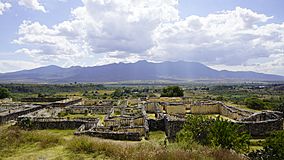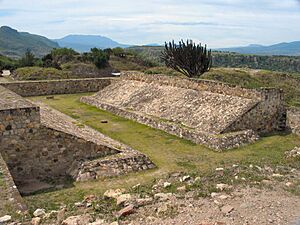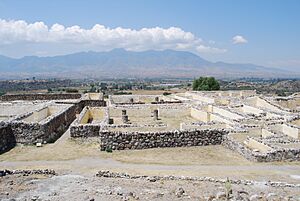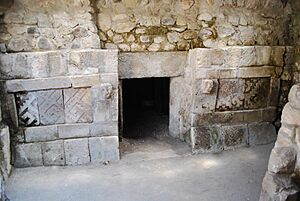Yagul facts for kids
Quick facts for kids Yagul |
|
|---|---|
|
IUCN Category III (Natural Monument)
|
|
 |
|
| Lua error in Module:Location_map at line 420: attempt to index field 'wikibase' (a nil value). | |
| Location | Oaxaca, Mexico |
| Nearest city | Tlacolula de Matamoros |
| Area | 1,076 hectares (2,658.9 acres) |
| Established | May 24, 1999 |
| Governing body | Comision Nacional de Areas Naturales Protegidas (CONANP) |
| UNESCO World Heritage Site | |
| Part of | Prehistoric Caves of Yagul and Mitla in the Central Valley of Oaxaca |
| Criteria | Cultural: (iii) |
| Inscription | 2010 (34th Session) |
Yagul is an amazing ancient place in Oaxaca, Mexico. It was once a powerful city-state of the Zapotec civilization. This civilization lived in Mesoamerica long before Europeans arrived. Yagul is also known as Pueblo Viejo, which means "Old Village."
People lived here when the Spanish arrived. After the Spanish Conquest, the people moved to the nearby town of Tlacolula. Their families still live there today.
Yagul was first settled around 500-100 BC. Important buildings like homes, government buildings, and temples were built between 500 and 700 AD. Most of what you see today was built later, between 1250 and 1521 AD. During this time, Yagul was the capital of a city-state.
Archaeologists Ignacio Bernal and John Paddock studied Yagul in the 1950s and 60s. They helped us learn a lot about this ancient city. Some cliff paintings nearby show that people lived in this area as far back as 3000 BC!
Contents
What Does Yagul Mean?
The name Yagul comes from the Zapotec language. It combines two words: ya (tree) and gul (old). So, Yagul means "old tree."
Where is Yagul Located?
Yagul is found right off Highway 190. It's between the city of Oaxaca and Mitla, about 36 kilometers from Oaxaca. The site sits on a volcanic hill. This hill is surrounded by rich, flat land in the Tlacolula part of the Oaxaca Valley. The Salado river flows to the south of the site.
History of Yagul
People started living at Yagul a very long time ago, in the Middle to Late Preclassic periods. Archaeologists have found ancient burials here. These burials included special ceramic pots. They show that the powerful people of Yagul were becoming more like those from the big city of Monte Albán.
Just before the Spanish arrived, Yagul was a busy place. More than 6,000 people lived there!
Exploring the Site
Yagul is one of the most studied ancient sites in the Oaxaca Valley. It's built around a hill and has three main parts:
- The fortress
- The ceremonial center
- The residential areas
The buildings at Yagul are mostly made from river stones. These stones are volcanic rock like basalt. About 30 tombs have been found at Yagul. Some of them even have ancient writing carved on them!
The Fortress
The fortress is on top of cliffs to the northeast. It has natural and human-made walls for protection. From here, you can see the entire Tlacolula Valley. It has several lookout spots, including one you reach by a narrow bridge.
The Residential Area
The areas where people lived are on terraces around the hill. Homes from the Classic Period are to the northwest of the main ceremonial area. Simpler homes from the Postclassic period are thought to be around the center of the site.
The Ceremonial Center
The ceremonial center is the main part of Yagul that has been dug up. It's what visitors see today. This area has many large open spaces called patios. These patios are surrounded by impressive buildings. It also has a ballcourt and a special living area for important people.
Here are some of the cool structures you can see:
- The Ballcourt: This is where ancient people played a special ball game. It's the biggest ballcourt in the Valley of Oaxaca. It was built between 500 and 700 AD. A carved serpent's head was found here. It is now in a museum in Oaxaca. The court is 47 meters long and 6 meters wide.
- Palace of the Six Patios: This is a huge building with many rooms and hallways. It has three main parts, and each part has two patios surrounded by rooms. In each pair of patios, the northern one was probably a home. The southern one might have been for managing things. There's a tomb entrance in each patio. The walls were covered with smooth stones and stucco. The floors were red. One patio, Patio F, was different. It opened onto the ballcourt and other areas. It might have been used for meeting visitors.
- Patio 1: This is a large open area next to the Palace of the Six Patios. It has rooms on three sides. A temple is right next to it.
- Patio 4: This patio is part of a temple complex. It has four mounds around a central altar. It was used for a long time, from the Classic Period to the Postclassic. A sculpture of a frog is at the base of the eastern mound.
- Tomb 30: This tomb is from the Postclassic period and is under Patio 4. It has three rooms with decorated walls. The main room has two carved human heads on its front. The door to the tomb is a stone slab with ancient writing on both sides.
- Council Chamber: This is a long, narrow room. It was once decorated with stone designs. You entered it by steps from Patio 1. This room was probably used for important meetings, not for living.
- Decorated Street: This narrow "street" runs between the Palace of the Six Patios and the Council Chamber. Its southern wall is over 40 meters long. It was decorated with geometric stone designs, like those found at Mitla.
- Building U: This building is on a raised platform in the northern part of the site. A tomb is under its floor. You can reach it by stairs, and it offers a great view of most of Yagul.
The Instituto Nacional de Antropología e Historia (National Institute of Anthropology and History) takes care of Yagul. It is open for everyone to visit!
Yagul Natural Monument
In 1999, the Mexican Government made Yagul a natural monument. This means it's a special protected area. The monument covers about 10.76 square kilometers. The National Commission of Natural Protected Areas (CONANP) manages it.
See also
 In Spanish: Yagul para niños
In Spanish: Yagul para niños




